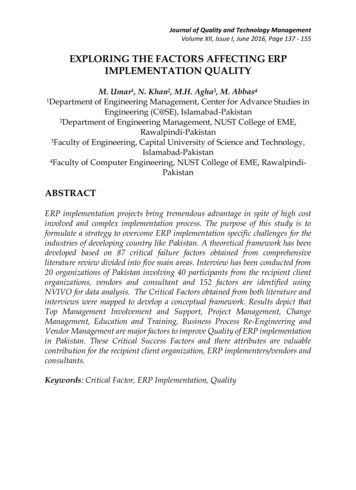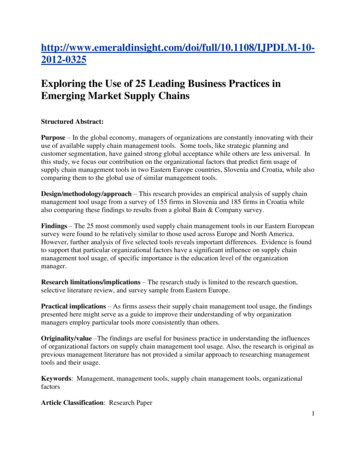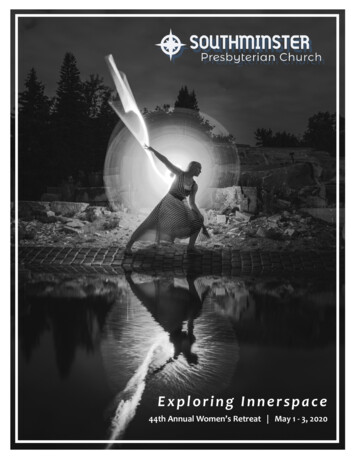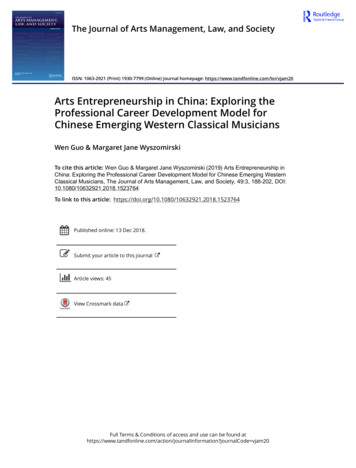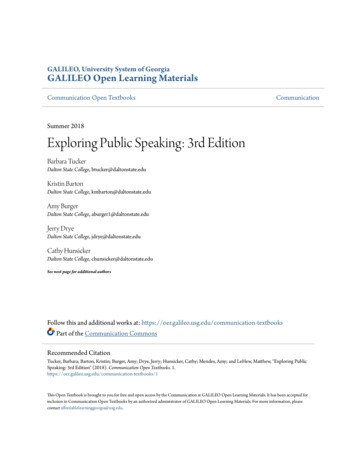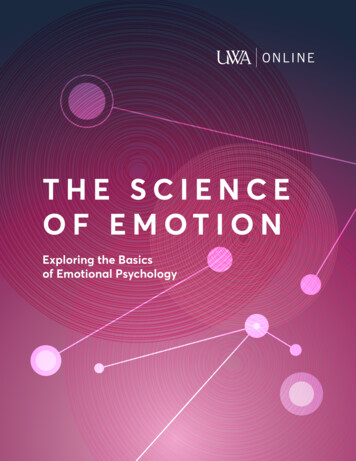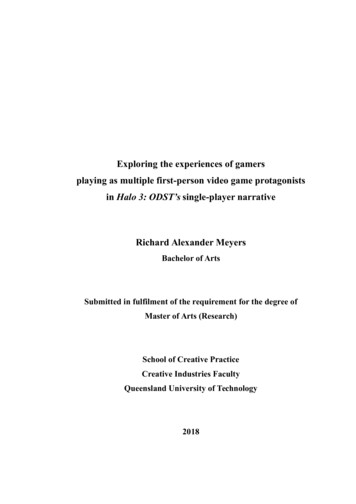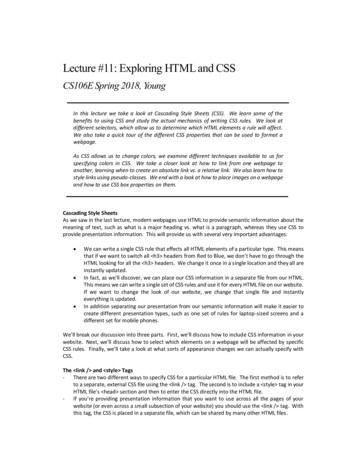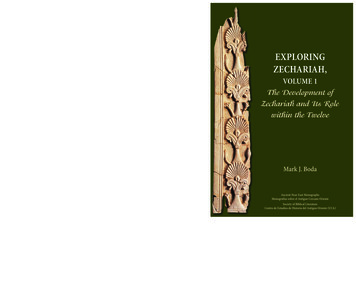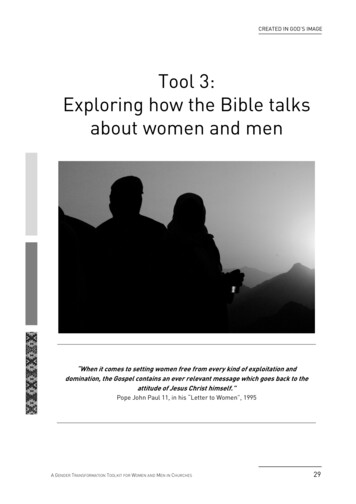
Transcription
CREATED IN GOD’S IMAGETool 3:Exploring how the Bible talksabout women and men“When it comes to setting women free from every kind of exploitation anddomination, the Gospel contains an ever relevant message which goes back to theattitude of Jesus Christ himself.”Pope John Paul 11, in his “Letter to Women”, 1995A GENDER TRANSFORMATION TOOLKIT FOR WOMEN AND MEN IN CHURCHES29
CREATED IN GOD’S IMAGETool 3 contentsIntroduction: Gender and patriarchy in the church . 30So what went wrong in the Church? . 31The Bible: Tool of oppression or liberation? . 31Promoting a more balanced theological understanding . 32Biblical texts that support gender discrimination . 33The Old Testament . 33New Testament Passages . 38Something more to think about. 40The Good News . 41Women were disciples of Jesus . 41Jesus respected women . 42Women as sex objects or ‘war trophies’ . 43Jesus took women’s lives and struggles seriously . 43Women were among Jesus’ close friends . 44Women were the first to proclaim the Good News . 44The personal image of God . 45Attachment: Alternative contextual readings of Scripture: three examples . 46Introduction: Gender and patriarchy in the churchThe Jewish and Christian religions grew out of a worldwhere men dominated in all areas of life: politics,religion, the economy and in the home. Everyoneassumed it was true that women and slaves, and evenchildren to some extent, were less than human, and weresimply possessions of men.This is called a patriarchal society, and many societies inthe world still operate on the assumption of malesuperiority.The Gospel stories, however, show that Jesus defied thispatriarchal view of the world: He spoke to women in public and risked publicdisgrace. He had women as close friends, discussed theologywith them, and even trusted women with the newsof his resurrection.30Katharine Jefferts-Schori, Presiding BishopDiocese North Dakota, USA.Source: virtueonline.comA GENDER TRANSFORMATION TOOLKIT FOR WOMEN AND MEN IN CHURCHES
CREATED IN GOD’S IMAGE He affirmed the courage of a woman with a menstrual disorder for breaking a taboo andcoming out in public in hope of obtaining healing. He challenged women’s traditional service role when he told Martha that Mary had theright idea when she preferred to sit and talk with him and learn from him rather than doinghousework. He scolded his disciples when they would not let children come to him. He put children atthe centre of things. He openly criticised authoritarian leadership; he directly challenged those who lorded itover others and taught his disciples that service, love and acceptance of everyone was howGod calls us to live.So what went wrong in the Church?Some say it was when Christianity became formally accepted as a state religion in the RomanEmpire when Theodosius I, the successor of Constantine the Great, formally made Christianitythe state religion in 380 AD.Others say it was much earlier, when some disciples of the early church began to argue aboutwhich of the apostles to follow and a competitive spirit set in.And still others refer to selective uses of texts in the Old Testament that describe God as anauthoritarian figure who demands absolute obedience to a strict code of rules, rather than usingScriptures that demonstrate the love, grace and mercy of God, who loves all of creation equally.The Bible: Tool of oppression or liberation?In the Bible there are examples of both patriarchal and liberating ideas about women. We exploresome of these in this tool, and talk about more positive ways to use Scripture.Many Christians ignore the liberating strands in our Scriptures. They tend to focus on thepatriarchal ideas which support their own social or cultural views about women’s inferiority. Thisraises questions about the way that our cultural and social prejudices affect the way that we readthe Scriptures. Tools 12 and 13 specifically look into how it has been possible that the Bible hasbeen misused to justify prejudices, and how to avoid these pitfalls. They show how we can readthe Bible in ways that allow the Holy Spirit to speak into our lives and our world in fresh ways thatare more consistent with the Gospel.Patriarchal attitudes towards women have continued throughout the life of the Church all overthe world. Even though women were very active in the early missionary activity of the church, theywere gradually excluded from leadership positions. Reasons given were that women weresexually impure, intellectually limited and passive. Even today, some churches say that womenare psychologically unsuited to be ordained. The church has also insisted that women shouldfocus on the home because of their natural roles as caregivers, since they give birth.A GENDER TRANSFORMATION TOOLKIT FOR WOMEN AND MEN IN CHURCHES31
CREATED IN GOD’S IMAGEAlthough many senior church leaders no longer accept these arguments, many of theseperceptions and attitudes about women continue today. Often this is not a conscious underminingof women, but is the result of an uncritical acceptance of social assumptions about women andmen.There are still ways in which these narrow interpretations of Scripture undermine the equalityand dignity of both men and women in churches. This happens: when women are excluded from office or leadership just because they are women; when churches use language in the church liturgy and official pronouncements that refersto God’s people as male (‘sons of God’, ‘all men’), when religious language defines God exclusively as male and does not consider the manyother ways of describing God that occur in our Scriptures, when the church exploits women’s work, e.g. when women are paid less for the work theydo, and when they are expected to take on service and nurturing roles just because theyare women, when women are sexually violated or abused by priests or ministers, or when the churchdoes not challenge sexual abuse of women among their members or in society.Time to talk In what ways do these things happen in your church? What are other examples of the way patriarchy operates in your church? What are the signs of change in your church?Promoting a more balanced theological understandingTo open up the conversation about the theological foundations of gender justice, this toolexplores different biblical texts and offers alternative perspectives. You will find some materialthat can be used to deepen your own understanding or for discussion in a group.In Practical Tool 2 you will find a summary of an exciting method of reading the Bible calledContextual Bible study. If we are to discern what the Holy Spirit is saying through these ancientsacred texts, we need to think deeply about when the verses were written, for whom and why; andhow they might apply in our society and in our lives today, given that our lives and perspectivesare so different.32A GENDER TRANSFORMATION TOOLKIT FOR WOMEN AND MEN IN CHURCHES
CREATED IN GOD’S IMAGEBiblical texts that support gender discriminationThe Old Testament5Biblical scholar, Cheryl Exum , lists a number of ways in which women are treated in the Hebrew(Old Testament) Scriptures: Women are mostly described in relationships of subjugation to men: few have names, andmost women are described according to their husband, son or father Women are often described as victims: courageous survivors’ stories are omitted Women do not tell their own stories: men put words in their mouths Being silent about women’s pain Women’s sexuality is usually described in terms of the virgin, the mother or the whore,while men’s sexuality is never labelled Women are often depicted as passive and men as active Women are expected to submit to authority and not to challenge it. Violence is often used toenforce this submission. Women are shown to operate in the home while men dominate both in public and at home,regardless of intellect, ability or choice.Time to talkDoing your own biblical researchLook up the following passages in your Bible and try to discover how many of the comments, onCheryl Exum’s list, apply to the women in these stories: Michal in 1 Samuel 14 & 18 and in 2 Samuel 6Jephthah’s daughter in Judges 11Tamar in 2 Samuel 13:1-22Vashti in Esther 1The Jewish girl (servant of Naaman’s wife) in 2 Kings 5:1-19Hagar in Genesis 16:1-16 and 21:9-21.Can you add any other ways in which women are marginalised in these or other New Testamentstories?5Plotted, Shot, and Painted: Cultural Representations of Biblical Women. Journal for the Study of the Old Testament Series.215;Gender, Culture, Theory, 3. Sheffield: Sheffield Academic Press, 1996.A GENDER TRANSFORMATION TOOLKIT FOR WOMEN AND MEN IN CHURCHES33
CREATED IN GOD’S IMAGELost in translation: The Creation stories in GenesisThe creation stories are basic to many other Scriptures, and have probably influenced genderrelations in the church and society more than any others. So it is worth revisiting them.There are two stories of the creation of human beings (male and female) in Genesis.Story 1: Genesis 1:26-28 (Common English Bible version)26Then God said, “Let us make humanity in our image to resemble us so that theymay take charge of the fish of the sea, the birds in the sky, the livestock, all the earth,and all the crawling things on earth.” 27 God created humanity in God’s own image, inthe divine image God created them, male and female God created them. 28 Godblessed them and said to them, “Be fertile and multiply; fill the earth and be goodstewards of it. Take charge of the fish of the sea, the birds in the sky, and everythingcrawling on the ground.”Time to talkThink and talk about these accounts by reflecting on the following questions: What does this account tell us about the way in which men and women were created?If both men and women are created in God’s image, how should we then see one another?Who, according to this account, has more authority – men or women?Who is responsible for reproduction and care for children?Who is to be the steward of the environment? How are they to treat plants, animals and theearth?Story 2: Genesis 2:7, 18-24 (New International Version)7God formed the man from the dust of the ground and breathed into his nostrils thebreath of life, and the man became a living being. 18 Then God said, “It’s not good forthe man to be alone. I will make a helper suitable for him.” 19 Now the Lord God hadformed out of the ground all the beasts of the ground and all the birds of the air. Hebrought them to the man to see what he would name them. And whatever the mancalled each living creature, that was its name. 20 Now the man named all thelivestock, all the birds in the sky, and all the beasts of the field. But for Adam nosuitable helper was to be found. 21 So the Lord God caused the man to fall into a deep34A GENDER TRANSFORMATION TOOLKIT FOR WOMEN AND MEN IN CHURCHES
CREATED IN GOD’S IMAGEsleep, and while he was sleeping, he took one of the ribs and closed up the place withflesh. 22 Then the Lord God made a woman from the rib he had taken from the man,and he brought her to the man. 23 The man said: “This is now bone of my bones andflesh of my flesh. She will be called a Woman for she was taken from a Man.” 24 Thisis the reason that a man leaves his father and mother and embraces his wife, andthey become one flesh.Source: Le Mans - Cathedrale St Julien CV 01en wikipedia.orgTime to talkBoth creation stories show that human beings are meant to be in relationship with each otherand with God. But the way they do this is very different.The second presents the man (Adam) as created first, and then the woman. How does this influence how people understand right relationships between men andwomen? Have you heard this passage preached on before, and how has it been used? What are some of the consequences for women (and men) in your community?A GENDER TRANSFORMATION TOOLKIT FOR WOMEN AND MEN IN CHURCHES35
CREATED IN GOD’S IMAGESome notes on translationGenesis was originally written in the Hebrew language. Because the Bible is so old and has beentranslated into almost every language on earth, some meanings can be lost in the process of6translation. Hebrew scholar Phyllis Trible has shown that this is what has happened to thisstory.Human or man?The word translated as the man in English, was ha-adam in the Hebrew. This literally means“creature of the earth.” So it would be more accurately translated as “the human”, which isgender neutral. It is not until the end of the passage, after the second human is created, that thehuman recognises himself as is (man) and his helper as issa (woman).Rib or side?The way the Hebrew is more accurately interpreted to mean that the one human was split intotwo equal sides (tsele).Helper or servant?The word translated as helper in the English was used in the Hebrew for military support (Isaiah30:5). The same word (ezer kenegdo) was used to describe the way in which God helps God’speople (Deuteronomy 33:29). So this word means something like helping each other as equals.Time to talkWhat does this mean for gender relations today?Reflect on the revised version of the Genesis 2 story, below, that has inserted words moreclosely reflecting the Hebrew original. How does this change your picture of a healthy relationship between men and women? If the man recognises the women as his equal, strong helper in times of trouble, as in theoriginal Hebrew meaning, how does this affect your view of gender roles in the home, inchurch and at work?6Phyllis Trible 1978, 1986. God and the Rhetoric of Sexuality. Augsberg Fortress Publishing.36A GENDER TRANSFORMATION TOOLKIT FOR WOMEN AND MEN IN CHURCHES
CREATED IN GOD’S IMAGE If this version of the story were used more in our churches, how would it change thechurches’ teachings and practices related to marriage and the roles of men and women inhome, church and society? How would it affect gender relations in society? In what ways can you use it in your own church?New International Version, with Hebrew meanings inserted7God formed the human (ha-adam) from the dust of the ground and breathed into thehuman’s [ha-adam] nostrils the breath of life, and the human (ha-adam) became a livingbeing. 18 Then God said, “It’s not good that the human (ha-adam) is alone. I will make thehuman (ha-adam) a helper (ezer kenegdo) suitable for the human (ha-adam).” 19 Now Godhad formed out of the ground all the beasts of the ground and all the birds of the air, andbrought them to the human (ha-adam) to see what the human (ha-adam) would namethem. The human (ha-adam) gave each living being its name. 20 The human (ha-adam)named all the livestock, all the birds in the sky, and all the wild animals. But no suitablehelper (ezer kenegdo) for the human (ha-adam) was to be found. 21 So God caused thehuman (ha-adam) to fall into a deep and heavy sleep, and while the human (ha-adam) wassleeping, took one of the sides (tsela) and closed up the place with flesh. 22 Then God madea woman (issa) from the side he had taken and brought her to the human being. 23 Thehuman (ha-adam) said, “This one finally is bone from my bones and flesh from my flesh.She will be called a Woman (issa) because from a Man (is) she was taken.” 24 This is thereason that a man (is) leaves his father and mother and embraces his wife, and theybecome one flesh.Time to talkGenesis and teachings about the man as the head of the householdRead Genesis 3: 16-20, in which God goes through all the consequences of Adam and Eve'sdecision to eat of the fruit.It is interesting that it is only AFTER the first humans have sinned against God and gone theirown way, that: God declares that “your husband will rule over you”. Adam takes it upon himself to name the woman (Eve), thus assuming authority over her asthe original human did when naming the animals.A GENDER TRANSFORMATION TOOLKIT FOR WOMEN AND MEN IN CHURCHES37
CREATED IN GOD’S IMAGEDiscuss the following questions, or any others you may have: Do you think it was God’s original intention in creating humankind that the ‘husbandshould rule over his wife’ (vs 16)? How does knowing this affect your understanding ofwhat might be a ‘redeemed relationship’ between men and women? How might this re-reading of Genesis 3 be helpful to the churches’ work of bringing about7gender justice and ending gender based violence in church and society?New Testament PassagesA number of passages in the New Testament make reference to the creation story to justify or tryto impose unequal power relationships and restrictive roles on men and women. We have seen8above that this contradicts the original intention of the texts.The role of women in the ChurchThere are 3 passages that are often used toargue against women in leadership roles inchurch.The writer of 1Timothy 2:11-14, who used hisown patriarchal interpretation of the creationstory to argue that women can only have asubordinate role in the church:“A woman must be a learner, listening quietlyand with due submission. I do not permit awoman to be a teacher, nor must womandomineer over man; she should be quiet. ForAdam was created first, and Eve afterwards;and it was not Adam who was deceived; it wasthe woman who, yielding to deception, fell intosin. Yet she will be saved through motherhood– if only women continue in faith, love andholiness, with a sober mind.”Patriarchal interpretation of sections of both the Old and NewTestament argue that women can only have a subordinate rolein the church. Source: PACSAThe same argument can be found in other New Testament Epistles, such as 1 Corinthians 14: 3435, which was written by Paul.7Prof Christina Landman offers a reinterpretation of the story of Eve, when she points out that after being cast out of paradise,Eve actually restored humanity’s relationship with God as the God of Grace (not of punishment) when she gave her childrennames reminding us of God’s grace8There are a number of reasons for this, and theologians and church historians have grappled with this question for many years.This is beyond the scope of this publication.38A GENDER TRANSFORMATION TOOLKIT FOR WOMEN AND MEN IN CHURCHES
CREATED IN GOD’S IMAGEThe following passages make the same basic point: Ephesians 5: 21-28 (read the whole passage in light of vs 21) Colossians 3:18ff Titus 2:4-5 1 Peter 3:1-7Time to talkHow might the earlier version of the creation story change your response to these teachings?Academics who study the history and origins of the Bible have gone back to the ancientmanuscripts from when these Scriptures were first written down. Some found that in manycases, the verses about the inferior position of women were added later, often in the margin ofthe original text. In other cases, one can see these were not part of the original text because latermanuscripts insert the verses in different places, showing that they may have also been takenfrom notes in the margin of the originals.It is important to know the history of the Bible, if one is to make sense of some of thecontradictions we see in these passages, especially because they seem to directly contradictwhat Paul was actually living out in his ministry.Some biblical historians point out that Paul was most likely influenced by his Jewish culture,which was very patriarchal. He wrote Galatians 3.28-29 much later, which seems to take himback to Genesis 1, which makes no reference to a distinction between male and female, but allhumans were created in God's image.There are places in Paul’s letters and in Acts, which show that he worked closely with a numberof women leaders in the early church. For example, in Romans 16, Paul mentions as many asnine women among the leaders he greets, who are understood to be prominent leaders in theirown right: Phoebe, Priscilla, Mary, Junia, Tryphana, Tryphosa, Julia, Nereus’ sister and Rufus’mother (‘a mother to me also’ in verse 13).It is clear from the way he talks that he has worked closely with them, and respects theirleadership in the church. For example, Paul says that Priscilla ‘is prominent among the apostles’(vs 7), which implies she may have actually been one of the early apostles. Biblical historianshave found evidence that Priscilla was literate in both Greek and Latin, and may have evenwritten down some of Paul’s letters (as he did not write his own letters but dictated them).A GENDER TRANSFORMATION TOOLKIT FOR WOMEN AND MEN IN CHURCHES39
CREATED IN GOD’S IMAGETime to talk How would this information strengthen a lobby for women’s ordination in the church?This question about church leadership is explored in more depth in Tool 9. Most of the cultures where Paul ministered were very patriarchal. How might theseteachings relate to the culture in which these writers lived? How do they relate to thedifferent cultures that influence us in Africa today? What might this mean for how we generally interpret Scripture today?Something more to think about How do we now deal with the problematic passages inthe Bible – are they authoritative for women or, indeed,9for the whole Church? (What does authoritative mean ?) How have women dealt with this dilemma in the past? What, if anything, has changed and why is it important tobegin to deal with passages of Scripture that seem torelegate women to the kitchen and to child care? Have you heard of Contextual Bible Study and do youthink it might be helpful? (See more about this approachto Bible study in Practical Tool 2.)“I am a male and itsuited me to have a Godmade in my image and tohave a Redeemer who islike me.”SbuTool 12 tries to address some of these thorny questions.9Authoritative basically means that “it is the Holy Spirit that helps us to confess the Bible to be the inspired Word of God. Butwhat does this mean? Some people understand this literally and for them the Bible is 'God’s Word' because God personallydictated every letter and word. Others believe that the Holy Spirit inspired the authors of the Bible to write about God’s greatdeeds in their own language, culture, idiom and experiences. Therefore we can only understand the Bible, not literally, butwithin context. A very important aspect of respecting the authority of the Word of God is not to force your own preferences orprejudices into your reading of God’s Word, but to take the Bible’s intended nature and purpose very seriously.” Inclusive andAffirming Ministries (IAM): “What does the Bible say about homosexuality?” In Gennrich, D. Ed. 2013 Men and Masculinities inSouth Africa. Pietermaritzburg: PACSA and Sonke Gender Justice.40A GENDER TRANSFORMATION TOOLKIT FOR WOMEN AND MEN IN CHURCHES
CREATED IN GOD’S IMAGEThe Good NewsJesus’ positive view of women is consistently evident throughout all four of the Gospels. Jesustreated women as equals and definitely not as sex objects or legal possessions. Jesus consideredwomen worthy of being a part of his circle. This section explores some inspiring examples.Women were disciples of JesusTime to talk Can you think of examples of women disciples in the Gospels?Complete the table below: Some Scripture verses are provided – read them and talk about the women and how Jesusrelated to them. Think of other Scripture verses that refer to similar women, and add the verses and namesof the women into the table below.Roles women played inJesus’ ministryThe women’s namesBible verses thattell their storiesWomen followed Jesus’ministry and supported it.Some women simply providedhospitality.Roles women played inJesus’ ministryLuke 8:1-3The women’s namesBible verses thattell their storiesOthers showed a deepunderstanding of his ministry.John 11:27Some women openlydemonstrated their love andrespect for Jesus and Hisministry.Luke 7:36-50Mark 14:3-9A GENDER TRANSFORMATION TOOLKIT FOR WOMEN AND MEN IN CHURCHES41
CREATED IN GOD’S IMAGEJesus respected womenDuring the time of Jesus, the women in Jewish culture were not educated, were only seen to besaved through the faith of their husbands: in fact they were not thought to have souls at all! Menwho spoke to women in public had to undergo cleansing rituals for having been defiled publicly.Women were regarded as ritually unclean during their menstrual period, and were forbiddenfrom preparing food or going out in public.Time to talkJesus the first male gender activist?Look up the following passages, which contain examples of Jesus relating publicly to women andeven discussing theological ideas with women. Talk about any of the stories that interest you: How do you think Jesus must have been received for breaking all these taboos? How do you think these women must have felt? How do you think the other characters in the story must have felt? What do you think Jesus was trying to do? The women who anointed Jesus (Matt 26:6-13; Mark 14:3-9; John 12:1-8; Luke 7:36-50);The woman who had menstrual bleeding for 12 years (Luke 8: 43-48);Syro-Phoenician woman (Matt 15:21-28; Mark 7:24-39);Samaritan woman (John 4:7-12);Mary and Martha (Luke 10:38-42; John11:20-33)What are some of the prejudices against women in your community today, and how do you thinkJesus would have handled them if he were walking your streets today? How do you think Jesuswants us to respond to these today, as his witnesses?42A GENDER TRANSFORMATION TOOLKIT FOR WOMEN AND MEN IN CHURCHES
CREATED IN GOD’S IMAGEWomen as sex objects or ‘war trophies’Jesus challenged the attitudes held by many people towards women as sex objects. There was aJewish practice (Deuteronomy 21:10-14) that allowed a man to take any woman captured in waras his wife. Jesus’ teaching in Matthew 5:28 against adultery prohibits men to lust after anywomen in his heart. This means he may not even think about her as a sex object, let alone takeher as a sexual possession or trophy of victory in war.Jesus took women’s lives and struggles seriouslyJesus had many interactions with women during the course of his ministry, showing that he careddeeply for the plight of women in his day. For example: the healing of the widow of Nain’s son (Luke 7:11-17) the healing of the Canaanite woman’s daughter who was possessed by demons (Matt15:21-28; Luke 13:10-17) the healing of Peter’s mother-in-law (Matt 8:14-15; Mark 1:29-31; Luke 4:38-39); Jesus’ encounter with the adulterous woman (John 8:1-11).Time to talkIn his parables and teachings, Jesus uses symbols and imagery from women’s lives, for exampleweddings, bread-making and childbirth showing that he was reaching out to women by usingthings they could relate to. What are some of the things that matter in women’s lives today? It might be interesting, ifyou are in a mixed group, for the men and women to answer this question separately, andthen come together to share their thoughts. Are these often mentioned in sermons and teachings in your church? How do you think it would make ordinary church women feel if sermons related to theirlife struggles more? How would it affect relationships between men and women, if at all?A GENDER TRANSFORMATION TOOLKIT FOR WOMEN AND MEN IN CHURCHES43
CREATED IN GOD’S IMAGEWomen were among Jesus’ close friendsWomen were his friends and he remained close to hismother. Think of the three Marys – who were they, andwhat were their relationships to Jesus? Among otherthings, they were the ones who were present during Jesus’last hours, at the cross, burial and resurrection (Matt27:55-61; 28:1-10; Mark 15:40-16:11; Luke 23:55-56;24:112,22-24; John 19:25-27; 20:1-18).Women were the first to proclaim the GoodNews“I used to think that God wasmale: God the Father andGod the Son. Then someonetold me that in both theHebrew and Aramaiclanguages, the Holy Spirit isin the feminine gender. I feela bit different about the HolySpirit knowing that.Somehow it makes me feelcloser to the Holy Spirit.”SenzaThe Gospels of Mark, Luke and John record that womenwere the first to receive the Good News of the RisenChrist.Both Mark and John record Mary Magdalene as the first person Jesus appeared to.Jesus recognised that women can be witnesses and messengers of important news, which wasnot permitted for women then.In Luke, we see that the disciples first refused to believe Mary (Luke 24:11), but they were provedwrong.Mary Magdalene is now often called the first evangelist, because Jesus sent her to go and sharethe Good News with the disciples. (John 20:17-18).Time to talk What are some of the argu
Exploring how the Bible talks . He openly criticised authoritarian leadership; he directly challenged those who lorded it . In Practical Tool 2 you will find a summary of an exciting method of reading the Bible called Contextual Bible study. If we are to dis
